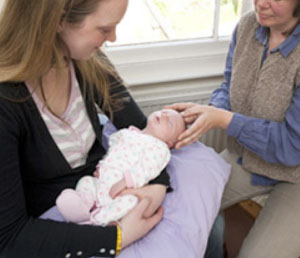Cranial Osteopathy
All osteopaths have a highly developed sense of touch or palpation. They have an extensive knowledge of anatomy and physiology and can detect very subtle physical imbalances in the body.
Cranial Osteopaths use very gentle and subtle techniques to ease out areas of tension and restricted mobility, help improve local circulation and help the body to return to a better state of balance and health.
A Cranial Osteopath is a fully trained osteopath who has chosen to undertake postgraduate studies in this particular gentle approach. Despite the name they are able to treat the whole body and not just issues relating to the head, although they do have a detailed understanding of the anatomy of the head and its 22 skull bones.

BABIES AND TODDLERS
The birth process
During birth, the baby is subjected to significant forces as he or she twists and turns to progress through the mother's relatively narrow bony pelvis. To make this easier, the baby's head is designed to adapt and reduce in size by bending and overlapping of the soft bones of the skull. This is called moulding, and is why many babies are born with oddly shaped heads. In the first few days after birth, the head naturally loses much of the extreme moulded shape, aided by suckling, crying and yawning. But this unmoulding process may sometimes be incomplete, especially if the birth has been difficult, and can leave the baby with uncomfortable stresses in the head and/or body. This may cause a variety of problems both in the young baby and later on as the child grows.
Symptoms of discomfort
A baby who is uncomfortable will draw attention to something being amiss by:
- Crying
- Being unhappy or irritable for long periods
- Having difficulty falling or staying asleep
- Showing signs of digestive discomfort
- Preferring to feed on one side.
Once all the usual causes of discomfort such as hunger, tiredness, bringing up wind etc have been dealt with, some babies are still very uncomfortable. Osteopaths consider that this can often be because of physical discomfort.
Signs of asymmetry in a baby or child
- Misshapen head
- Ears may not be level and one may stick out more
- Eyes may be a different size
- Preference for breastfeeding on one side
- Difficulty turning head one way
- Baby prefers to lie in a bent position
- Crawling with one foot tucked under the other
- Walking with one foot turned in.
Behaviour
Before a child has learnt to express itself verbally, it has to find other means of communicating. Sometimes a child may be awkward, uncooperative or just plain difficult, especially when tired. If a child has physical imbalances and tensions, then difficult behaviour may be their way of expressing their discomfort. When these tensions are released they often become much happier and more relaxed.
Occasionally a child's behaviour can alter after sustaining a fall, a common occurrence when the child is toddling or learning to walk.
Osteopaths are trained to be able to assess the physical state of infants and children to determine if there are any physical reasons for their difficult behaviour.
The osteopathic assessment
An osteopath is interested in every aspect of the health of the child, and will begin the consultation by taking a detailed case history. This can include questions about the pregnancy and labour as well as information about accidents, infections, and development.
Treatment
Osteopaths are trained to diagnose and release strains and tensions even in the youngest of babies. In assessing a newborn baby the osteopath checks for asymmetry or tension in the pelvis, spine and head, and ensures that a good breathing pattern has been established.
In a research study conducted by Clive Hayden into the effects of cranial osteopathic treatment on babies, some parents perceived the following changes in their children's behaviour:
- reduced colicky crying
- improved sleep
- less unsettled irritable behaviour
- increased quiet, happy spells.
Osteopathic treatment of babies and children Is very gentle, and they often happily play with toys or interact with a carer during treatment.
After treatment
The most common response is for children to feel tired and sleepy for a few hours after treatment. Some children may become very energetic for a few hours.
Occasionally a child may appear to be unsettled for about 48 hours followed by a general improvement. If a child is unhappy for longer than 48 hours then it is advisable to contact your osteopath.
Please contact your osteopath if you wish to discuss your child before booking an appointment.